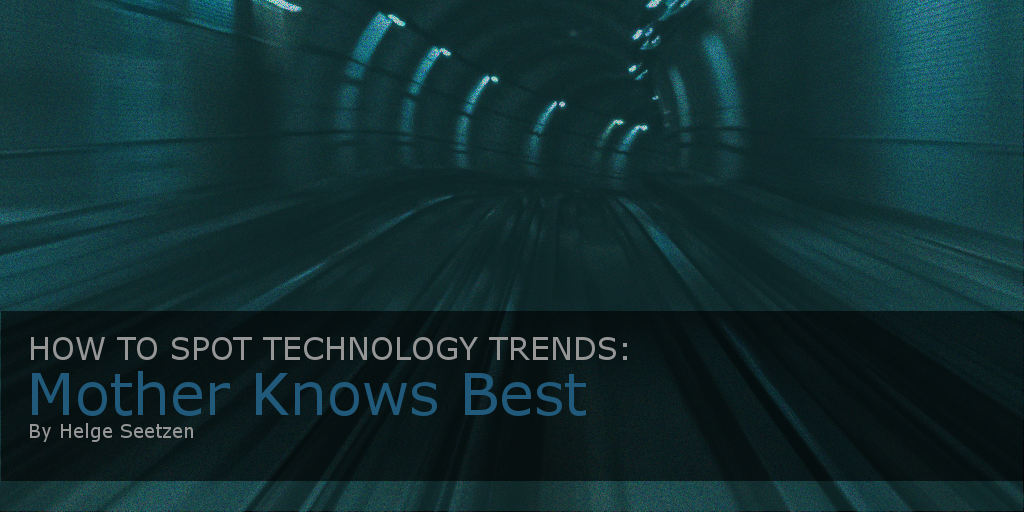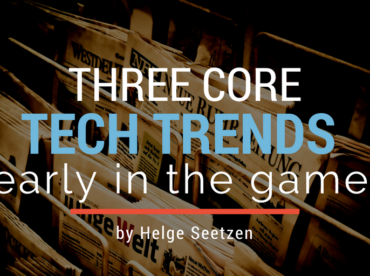Spotting technology trends is a subject that is at the forefront of our minds at TandemLaunch. While I can’t offer any silver bullet solutions, this will be the first of a 2 post series on the subject. I look forward to some good discussion on the topic.
When you build a product or design a technology that will actually become a product, there are really only two business models. There is B2B (business to business), where you try to make an operational aspect of your customer business more efficient, and B2C (business to consumer), where you ultimately try to create great products that enable human beings to do what they like to do. I will focus on B2C products.
The question, of course, is how to find out what people like to do. The answer is to talk to my mother. What I mean is that you look at a demographic in the main stream, that is not a technological leader in particular, and that has no patience at all for technology hikes. In fact, a demographic that generally does not even understand hikes. If you are in my age group, that demographic is your parents. It might sound insane, but I look at my mom as a predictor for the technological future because she barely knows how to use a computer, she certainly couldn’t use the Commodore 64 that I started writing simple lines of code on, and her knowledge of computers in the last 20 years has not improved dramatically. Here’s the thing though, my mom has a long list of things that she would like to do, that technology can enable, and she would clearly buy these products if they were available.
For all of you eager and aggressive entrepreneurs in the tech space, it seems silly to look at a past generation to define what the future might be, so let’s look at an example. My mother lives a continent away and wants to see her grandchildren. ‘No problem,’ says technically savvy me. We end up buying a TV with a built in camera, get Skype set up, and when I’m all pleased with the setup I’ve created, my mom points out that the image is not so great. I stare blankly at the image, trying to diagnose the problem, and figure out what has gone wrong on her side. Ultimately, I realized that her side looks just like my side. But my side looks fine. Why?
On my side, I’ve mentally ignored a whole bunch of compression artifacts, small distortions and other little things that somebody who is savvy in the video processing world would just discard and filter out. My mom doesn’t. My mom wants to see a picture of her grandchildren that is pretty clear the way it would look like on a photograph, or even better, the way it looks like when they are right in front of her. Over time I have learned that my mom and people like her make all kinds of ‘unreasonable requests’ for realism, quality, or systems that they can operate like the objects they are already used to. A lot of times when people don’t have an intuitive understanding of what is technically feasible, they simply articulate what they want to do based on how they do it from one human to another human. If you were to see my children in person, they would look crystal clear, in full colour, and in three dimensions. Of course this is what my mother wants. Unless somebody tells her that it is not possible, she will continue to ask for it. And if someone were to make it possible, she would spend her disposable income on it.
Furthermore, the economic future of most of our major web 2.0s or current technology successes are based on people like my mom. Facebook was put on the map by college kids that were into this ‘new social media thing,’ but if Facebook is ever going to have any hope of economic success, truly monetizing and having a long life, then it has got to tap into the average user: the 43-50 year old woman who plays Farmville all day and has disposable income to spend in the system. These people are the actual monetizing users. In Facebook’s case they are both the money driver, and in some sense the product (their information gets sold to advertisers and makes even more money).
Like my mom, this demographic not only has a profound economic impact on future business, they are one of the best indicators of how the future will look because they don’t have the same mental limits that people who are knowledgeable about technology intrinsically have. They are easily able to articulate what they want, and they don’t let the ‘technically possible’ limit what they ask for.


